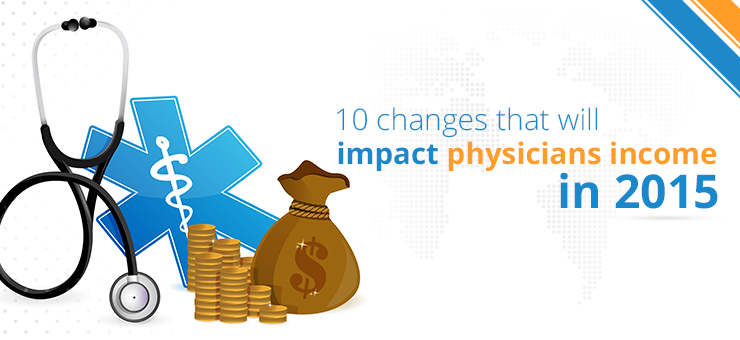With the upcoming changes in 2015, physicians can expect to face some major challenges along with a few opportunities, when it comes to generating income. These changes are likely to impact most practices and can impact physician income to varying degrees. Watch out for the following changes:
- Increase in high deductibles
Patient collections have become an issue for physicians due to high deductibles of $1,000 or more. A study conducted by Kaiser Family Foundation reported that 80% of employees have deductibles, with 18% having $2,000 at least. - Malpractice premium decrease
After years of high malpractice premiums, there has been a gradual decrease in the malpractice insurance premium. This trend is expected to continue into 2015. - Keep room for ICD-10
There is an air of suspicion in the healthcare industry regarding the ICD-10 deadline. With no notification from CMS about a delay, physicians are getting anxious as the deadline comes closer. They fear that the new coding system may not work, which can heavily impact revenue. - ACO losing its protective shield
ACOs enter a crucial stage, as their three-year contract for shared savings will expire in 2015. After this, ACOs that decide to remain in this program may face huge possible financial penalties. - Telemedicine picks up pace
This may be worrisome for physicians with no telemedicine experience, as a sharp increase is expected in the use of telemedicine facilities by patients in 2015. It has been noticed that web and telephone medical consultations are growing by leaps and bounds. - Growth in Retail clinics
There has been a steady growth in retail clinics – such as the clinics in pharmacies like Walgreen’s and Rite-Aid. According to health Affairs, there has been a 400% increase in the number of patients visits to retail clinics, from 2007 to 2009. - PCPs to return to old Medicaid payments
Previously, Medicaid payments for PCPs had increased to Medicare levels. In 2015, PCPs will face a tougher time, as Medicaid payments will gradually fall back to 40% of Medicare. - Meaningful Use penalties on the rise
Starting in 2015, Medicare’s Meaningful Use program will shift from incentive to penalty mode. From 2015 onwards, physicians can no longer attest to receive Meaningful Use incentives, as they end in 2016. In the meantime, MU penalties will continue to rise gradually from 1% to 3% by 2017. - PQRS penalties set in
Another Medicare program, Physician Quality Reporting System (PQRS) enters its penalty phase in 2015. Physicians who haven’t reported under this program will incur 1.5% penalty this year, while the penalty increases to 2% in 2016 based on 2014 reporting period. - Medicare’s Chronic Care Management
Finally, some pleasant news for physicians in 2015. This year CMS begins a chronic care outreach program. The program will pay physicians for providing healthcare facilities to Medicare patients with at least two chronic conditions. Physicians will be able to qualify for the incentives, even if the consultation is provided via phone or email, rather than face-to-face. Under this program, physicians will be paid $40.39 per patient for 20 minutes of consultation, which is particularly beneficial for primary care physicians.

Join the Discussion!